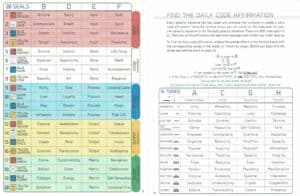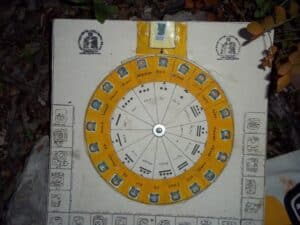This past September, I filled in spontaneously at our local astrologer group, SCAN (Southern California Astrological Network), as the monthly speaker to present a lecture about Mayan Astrology.
I have lived full-time in the Mayan territory for 12 years, where I had close contact with elders, shamans, and timekeepers of the traditional kind. I was introduced to this by my former life partner who was a traditional conchero dancer in a group in Playa del Carmen at the time. He also had a substantial library on astrological topics, and that’s when I really caught fire to study Astrology more seriously. I have always had an affinity for astrology, but from here I wanted to take it to a more professional level.
From 2004 onward, I was deeply involved in studying Jose Arguelles’ work on the Mayan calendar. I calculated my “Dreamspell”, his version of Mayan natal interpretation. Each year I would print out the pocket calendar which started End of July, and I lived with the Gregorian and Mayan calendars simultaneously over a period of several years to experiment with it.
I still like the idea of a month consisting of four equal weeks, similar to the Chinese lunar calendar. It seems more natural to me than the scattered calendars of antique Roman leaders with months between 28 and 31 days, which I feel named calendars or months in their name to serve their ego (emperors Julius Caesar and Caesar Augustus; Pope Gregory XIII).
When a friend gifted me the book How To Practice Mayan Astrology by Bruce Scofield and Barry Orr in the game-changing year of 2012, I had already dropped my “double calendar life”. But now I was really confused, because I had lived with Arguelles’ calendar for years, and per Scofield & Orr my day sign wasn’t Caban (Earth), but Etz’nab (Flint Knife, Mirror). Many years later, when I started to flirt with Human Design, I found that the Mayan “Mirror” made sense as a Reflector.
Researching and compiling information for my lecture about Mayan Astrology was extremely helpful to gain a bird’s eye view and draw comparisons between the leading heads on the topic.
In a nutshell, Mayan Astrology is a fully time-based system where blocks of time hold certain qualities and are ruled by gods. Several parallel counts run endlessly and interface every so often. A native falls in between several cycles which define character, personality, and potential. The most dominant counts are the 20 Day Signs and 13 Numbers (Trecena), and the most known calendars are the Tzolkin (sacred), the Haab (civilian), and the Long Count.
I do like the Burner Days. They are derived by dividing the 260-day Tzolkin calendar into four equal quarters of 65 days. On these days, the tribe came together to realign with their values and intentions and make corrections if they got off track.
SCAN recorded the lecture and you can purchase it for $15 if you wish. This includes the slides in PDF format. Please email me, if you are interested.


